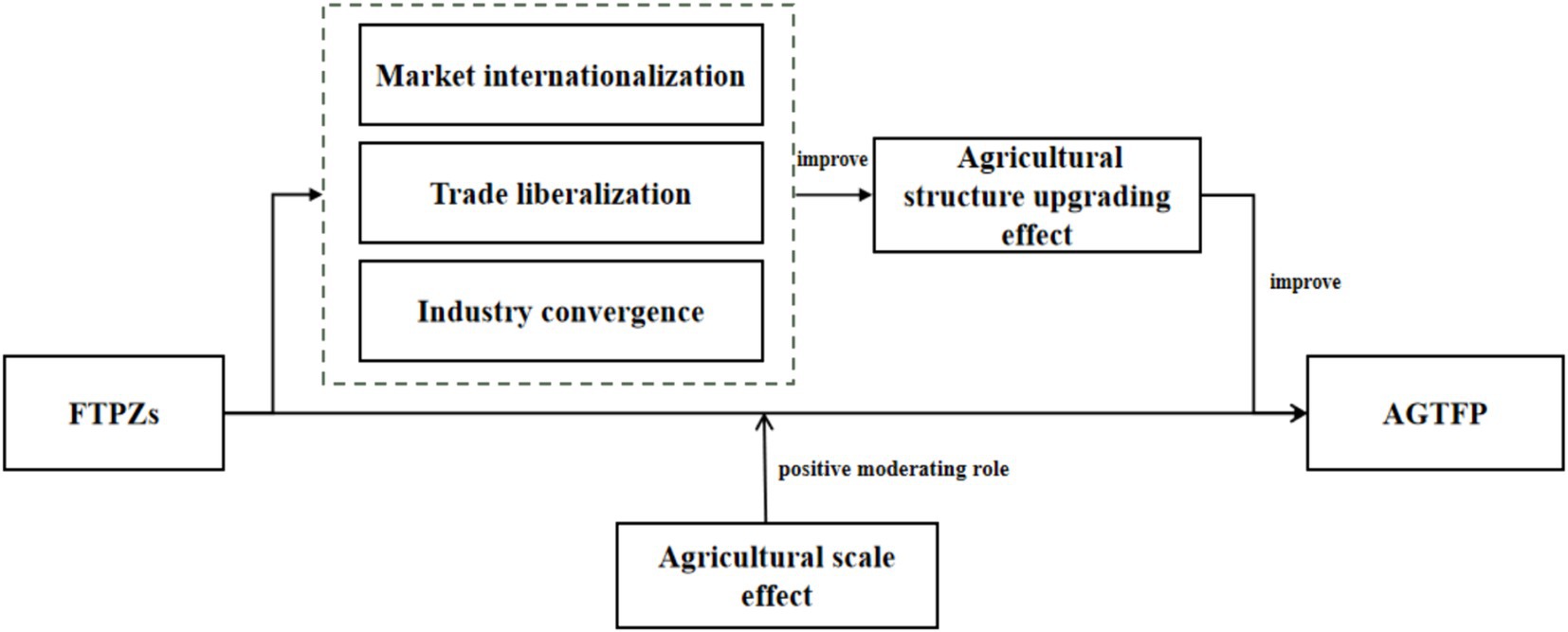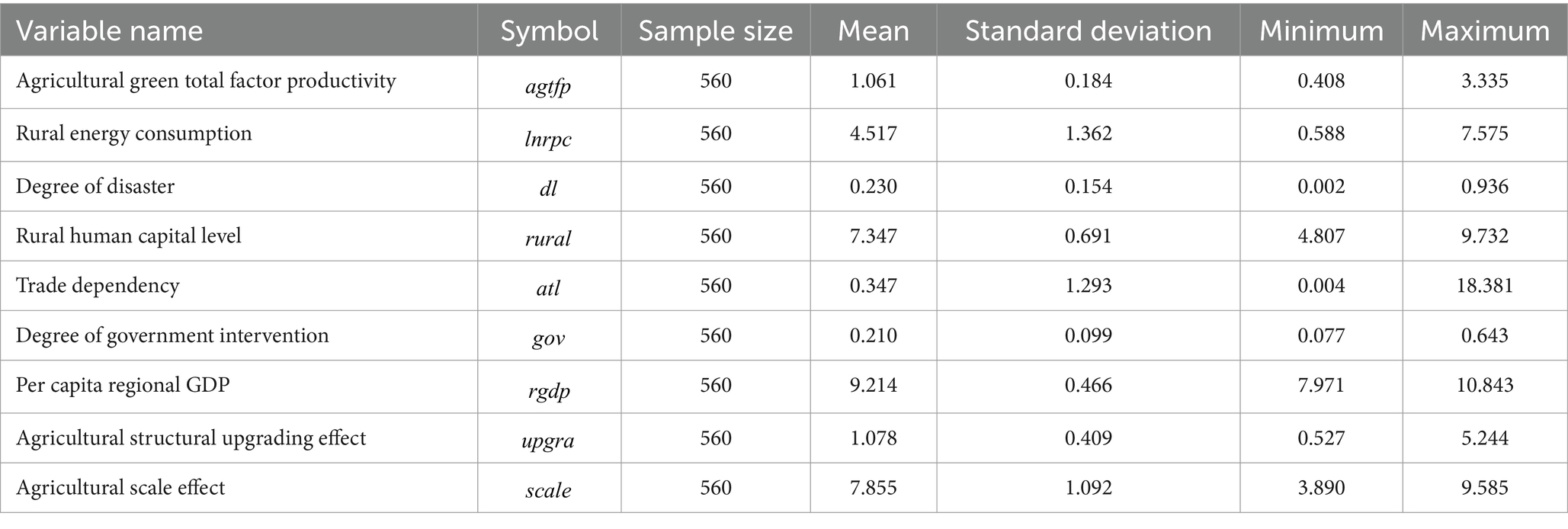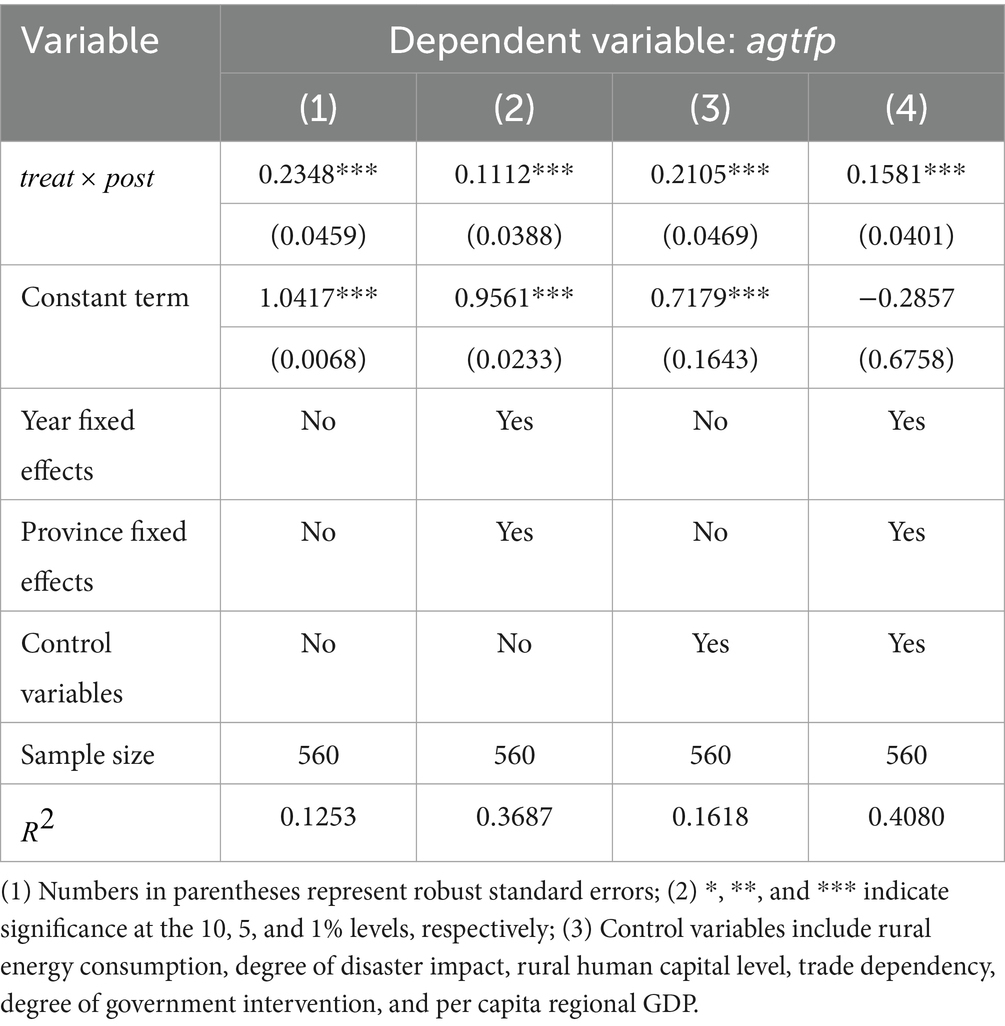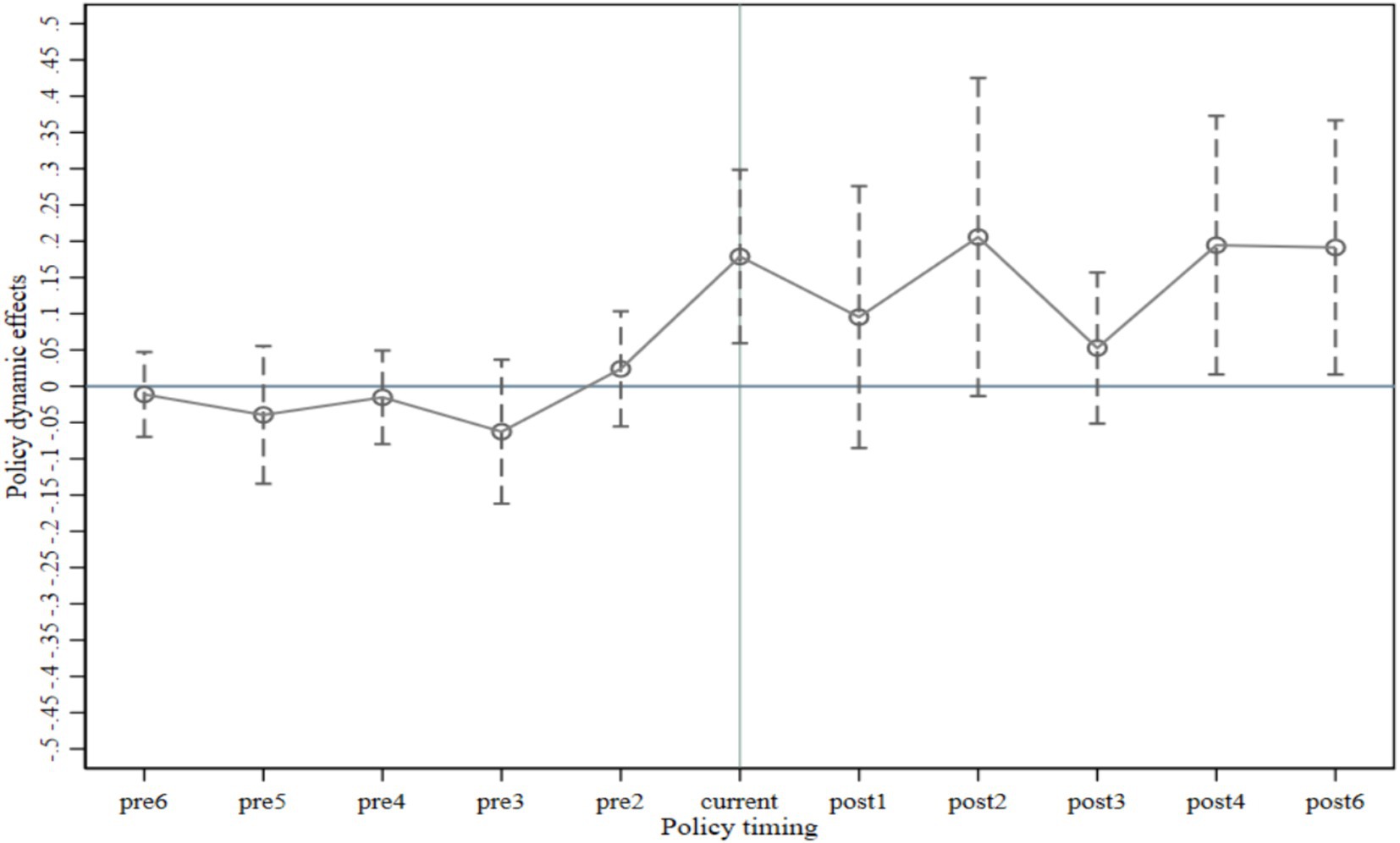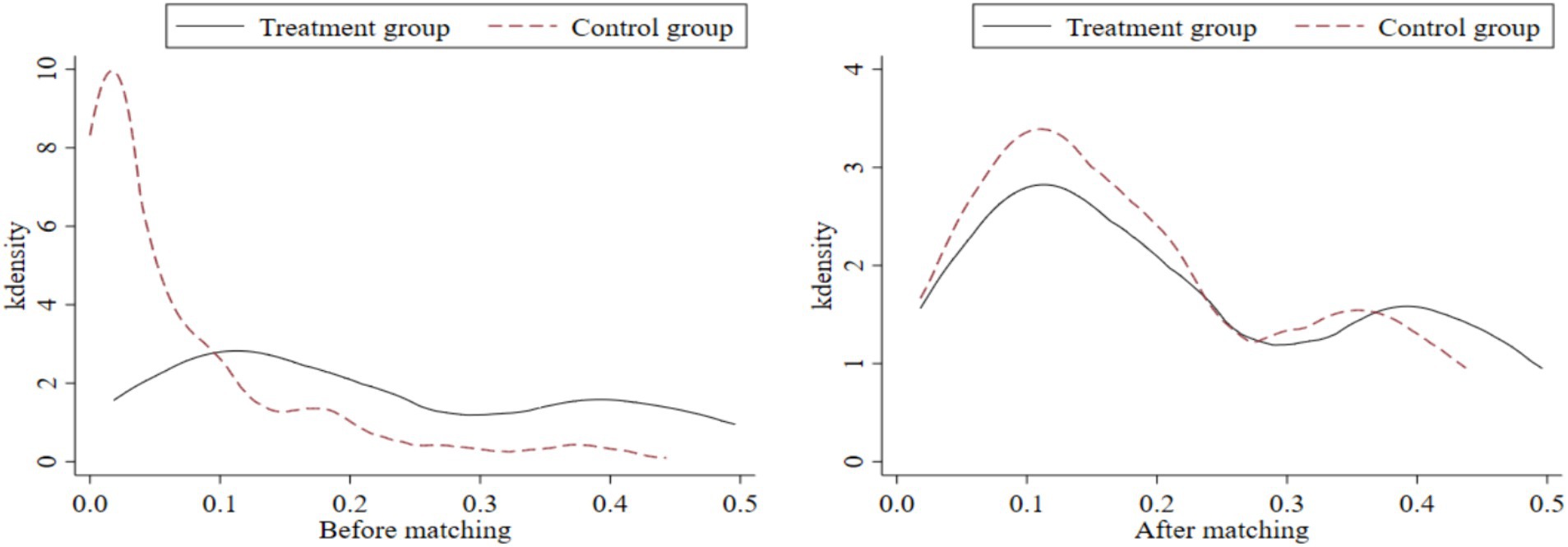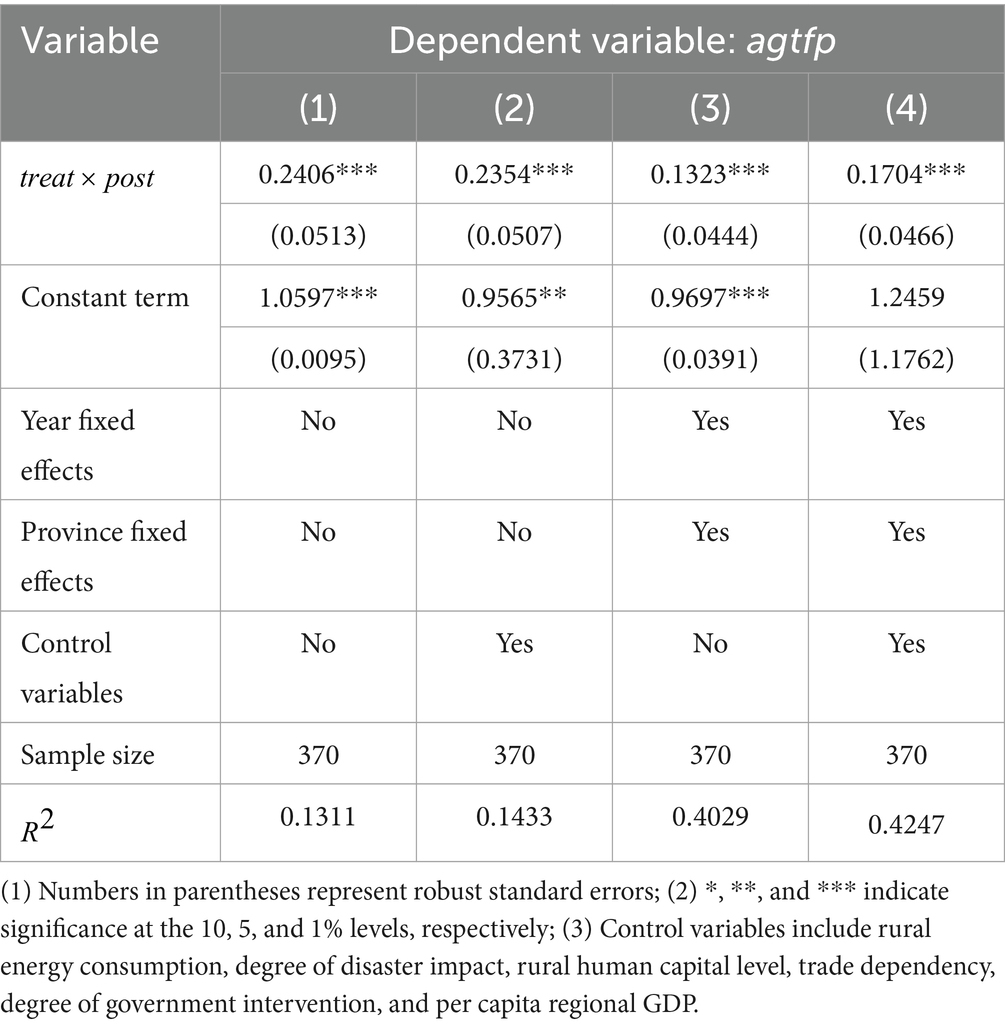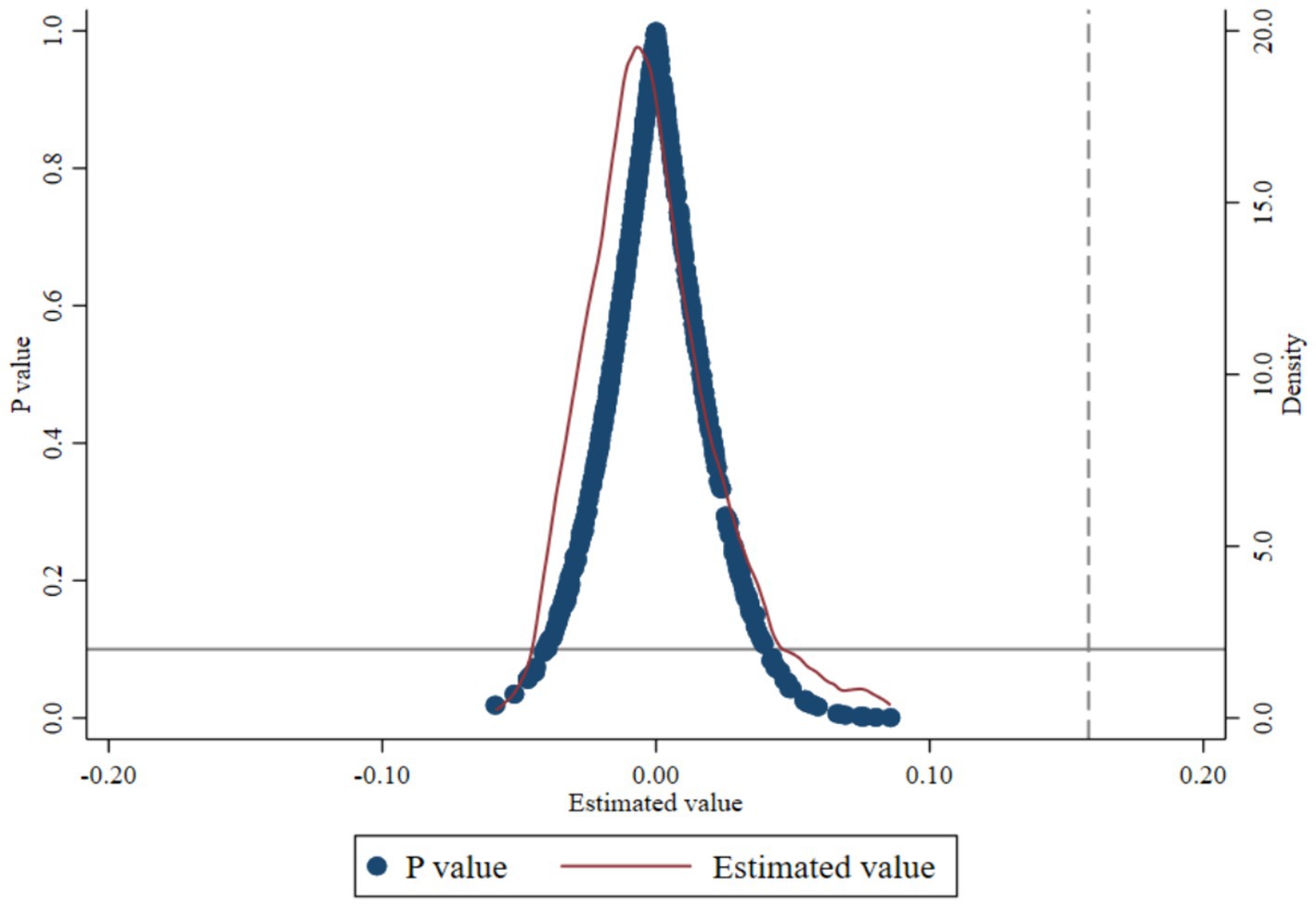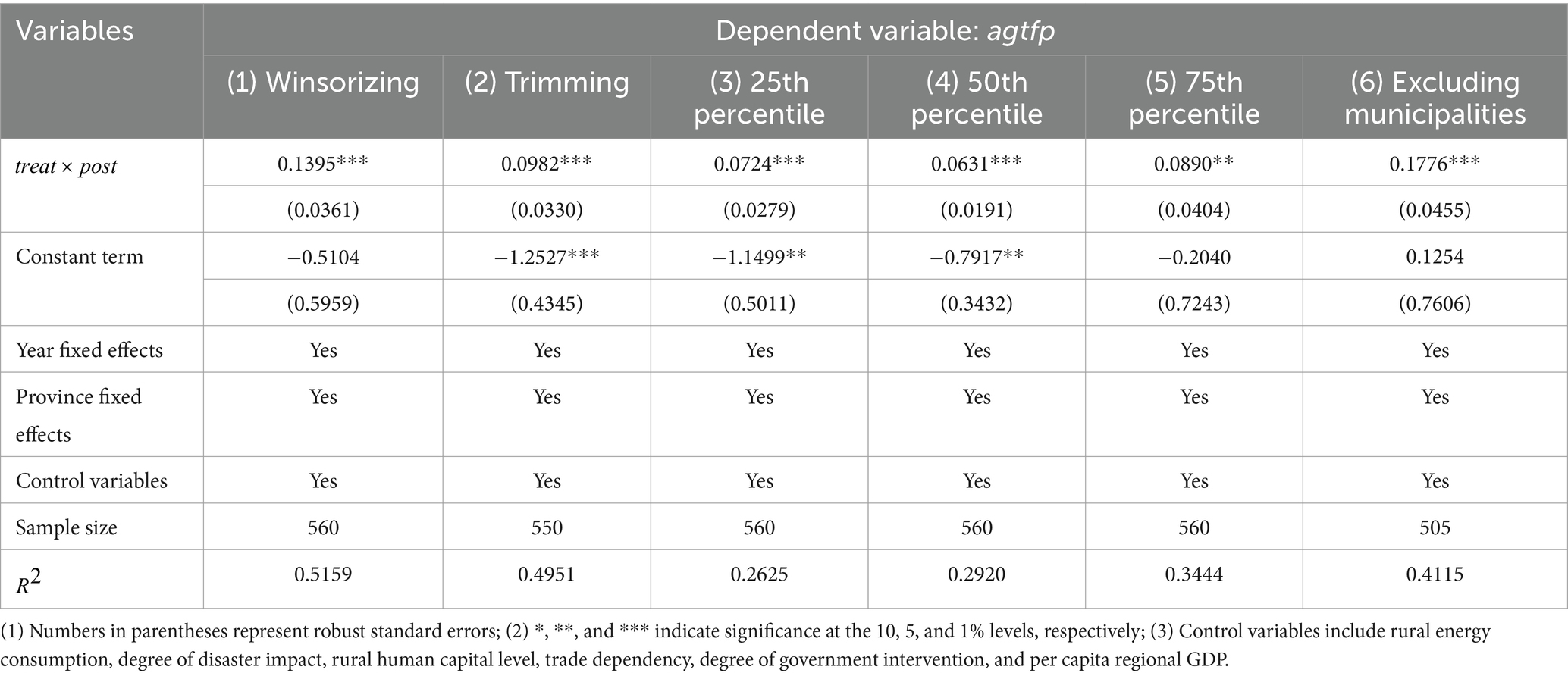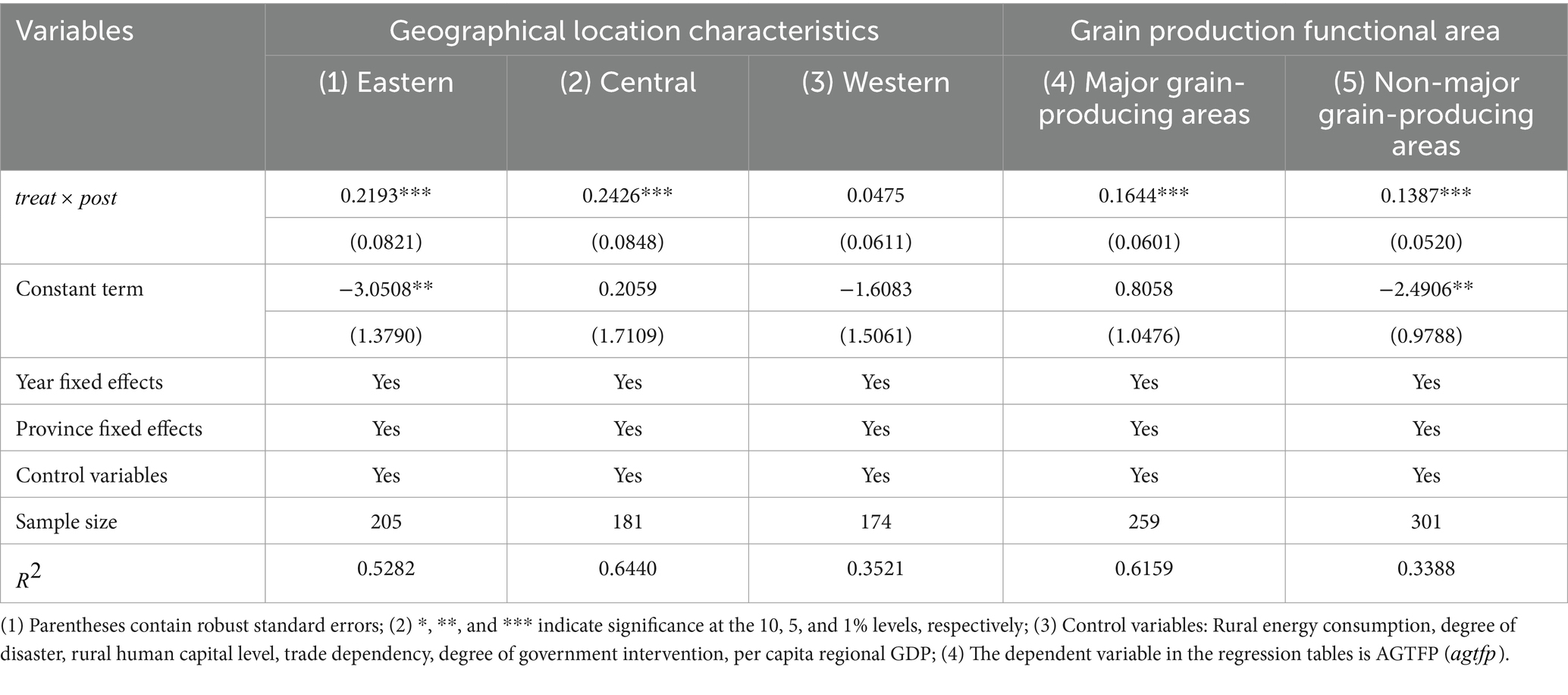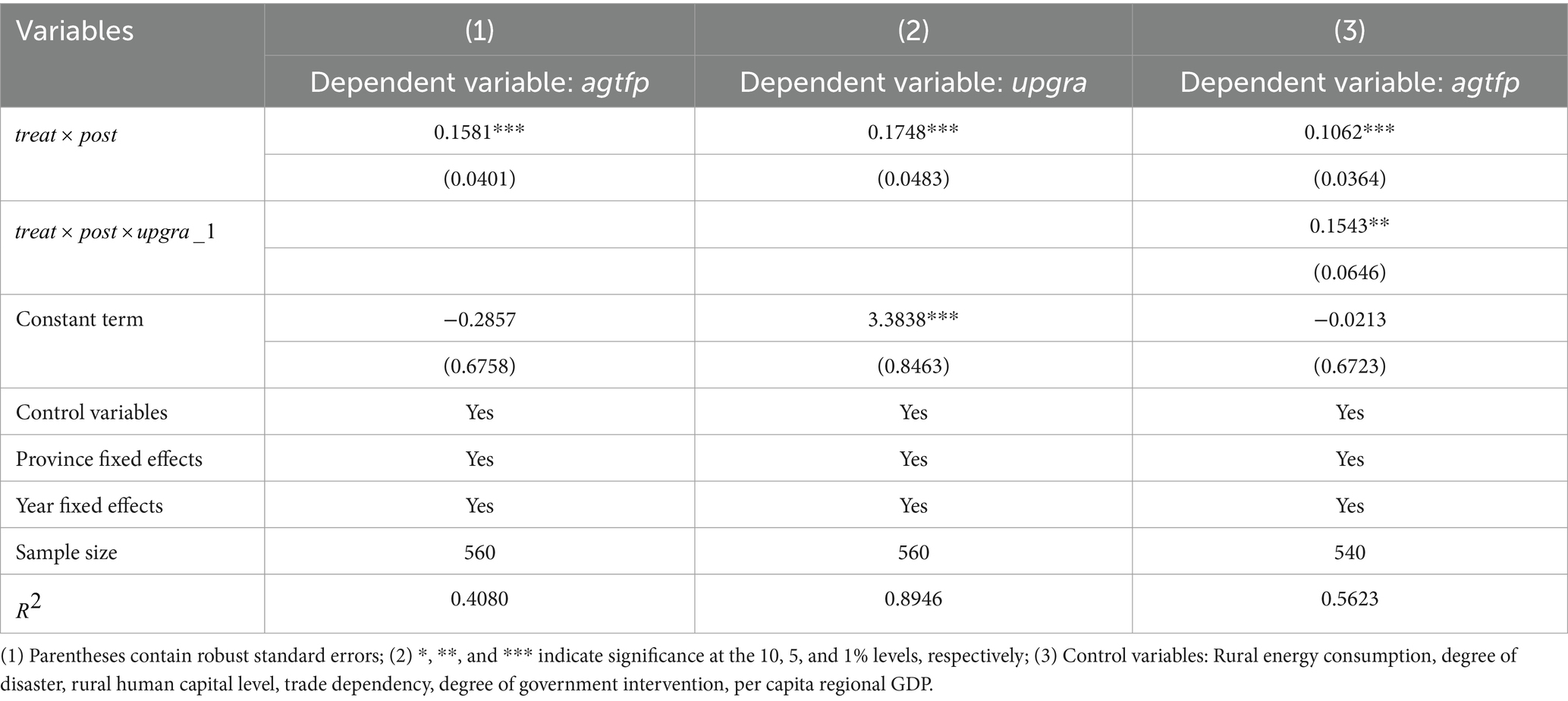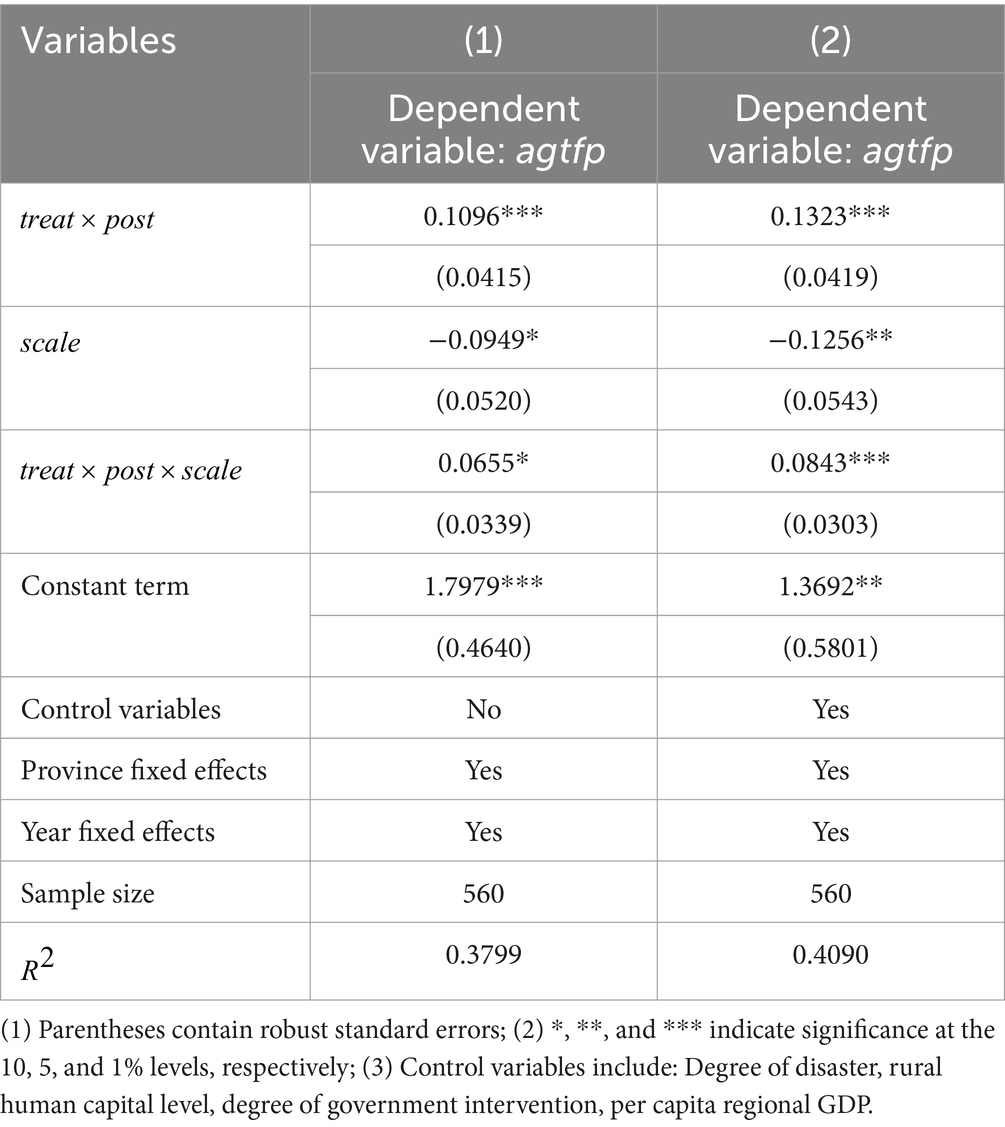- 1School of Business, Yangzhou University, Yangzhou, China
- 2School of Economics and Management, Guangxi Normal University, Guilin, China
Introduction: Given the dual constraints of limited resources and environmental concerns, achieving green development in agriculture helps to enhance national food security, resource security, and ecological security.
Methods: Utilizing panel data sourced from 30 provinces within China, spanning the years from 2001 to 2021, this paper employs the super-efficiency Slack-Based Measure (SBM) model and the Global Malmquist-Luenberger (GML) index to measure agricultural green total factor productivity (AGTFP). It utilizes methods such as the stepwise Differences in Differences (DID), mediation effect models, and moderating effect models to systematically explore the impact of the implementation of Free Trade Pilot Zones (FTPZs) on AGTFP and its mechanisms of action.
Results: The study finds: (1) Establishing FTPZs significantly boosts AGTFP, indicating a profound positive influence; (2) The promotional effect of FTPZs on AGTFP is stronger in the eastern and central regions, as well as in major grain-producing areas; (3) FTPZs may enhance AGTFP by promoting the effect of agricultural structure upgrading, i.e., a transmission mechanism exists from FTPZs to the agricultural structure upgrading effect to AGTFP; (4) The agricultural scale effect plays a positive moderating role in the impact of FTPZs on AGTFP.
Discussion: It is advisable to optimize agricultural measures related to FTPZs, promote agricultural structural upgrading and scale enhancement, adapt strategies to local conditions to advance green agricultural development, and thereby promote the coordinated development of FTPZs and AGTFP.
1 Introduction
The issue of environmental pollution has escalated into a global challenge. It is no longer confined to specific regions or countries; it is a critical issue that crosses borders and affects the collective future of humanity. Agriculture is identified as a significant source of ecological pollution due to substantial carbon emissions and pollutants from its production processes (Hou and Wang, 2022). To mitigate pollution from agricultural activities, countries worldwide have adopted green agricultural development models aimed at achieving low energy consumption, low emissions, and high efficiency (Chen et al., 2023). For instance, the United States established a sustainable agricultural development system and related policy incentive programs in the 1980s to minimize the application of fertilizers and pesticides, thus enhancing agricultural green development. Since 1992, the European Union has pursued a green transformation in agriculture through extensive policy reforms, gradually reducing environmental pollution and strengthening its green orientation while lowering the production-increasing orientation of agricultural policies. As a major agricultural country, China faces a dilemma between agricultural development and environmental protection due to its constraints of having a large population and limited land resources. Traditionally, agriculture has relied on increasing inputs of fertilizers and pesticides to boost production, a practice that, while contributing to the modernization of agriculture and increased yields, has exacerbated non-point source pollution and carbon emissions, posing significant negative impact on the environment (Liu and Feng, 2019). For instance, the current utilization rate of fertilizers and pesticides in China is only 41%, which is lower than the rates of over 50% observed in developed countries in Europe and America, resulting in a substantial amount of residual chemicals from agricultural production. Against this backdrop, attaining sustainable growth within agriculture and enhancing the green total factor productivity (AGTFP) of the sector is now of particular significance.
Free Trade Pilot Zones (FTPZs) are multi-functional economic special zones delineated within the borders of a sovereign nation but outside its customs territory. The FTPZs in China differ from those in other countries in that they are established to test new economic policies and reforms, with a focus on innovation (Jiang et al., 2023). Upon successful reform, these policies are replicated and promoted nationwide, thereby propelling the overall Chinese economy toward high-quality development (Wan et al., 2014). Up to this point, the Chinese government has established 22 FTPZs in 7 batches, generating a plethora of innovative outcomes. As a crucial element of China’s reform and opening up, the liberalization of agriculture has become a key focus within these FTPZs (Lu and Cui, 2022). For example, an increasing number of FTPZs are leveraging the current agricultural status and characteristics of their regions to introduce measures targeted at agricultural development, serving as a demonstration for agricultural advancement. Instances include the Yangling area in Shanxi FTPZ, which focuses on agricultural science and technology innovation; Heihe in Heilongjiang FTPZ, which develops cross-border green agricultural products; and Changsha in Hunan FTPZ, which establishes demonstration sites for agricultural science industries. These measures provide opportunities and conditions for the green development of China’s agriculture and the enhancement of its green total factor productivity. This raises questions: How do FTPZs enhance AGTFP, and what are the underlying mechanisms? This study investigates the impact of FTPZs on AGTFP and their mechanisms, providing insights from China’s experience that could guide the green development of agriculture globally, offering substantial practical significance and value.
Existing research predominantly focuses on the measurement of AGTFP and the examination of its driving factors. In terms of AGTFP measurement, traditional agricultural productivity metrics often overlook the restrictive impacts of environmental and resource limitations on agricultural economic growth, as well as the ecological benefits of agricultural development (Tang et al., 2023). Consequently, some scholars have proposed integrating factors related to the environment and resources into the agricultural total factor productivity measurement system, thus coining the term AGTFP (Reinhard et al., 1999; Xu et al., 2020). Researchers mainly utilize Stochastic Frontier Analysis (SFA) and Data Envelopment Analysis (DEA) to assess AGTFP. The DEA model, unlike the SFA approach, offers benefits in managing various inputs and outputs without necessitating a predefined production function and has become the mainstream method for measuring AGTFP (Xing et al., 2023). Several DEA models are prevalent, with scholars commonly employing the Malmquist-Luenberger (ML) index (Zhang et al., 2016) and the Global Malmquist-Luenberger (GML) index (Fang et al., 2021; Gao et al., 2022) for these measurements. Concerning AGTFP’s influential factors, recent investigations have predominantly examined the effects of internet use, technological innovation, digital finance, digital agriculture development, agricultural insurance, and other factors on AGTFP (Wang et al., 2024; Huang and Ping, 2024; Li et al., 2023; Zhou et al., 2023; Li et al., 2022a,b). However, direct research on how FTPZ implementation affects AGTFP is notably scarce in the existing literature.
Several scholars have delved into the impact of implementing FTPZs on the green development of urban areas. For instance, using the Shanghai FTPZ as a case study, researchers have found that the zone facilitated technological innovation that reduced urban environmental pollution and promoted green urban development (Jiang et al., 2021; Wang et al., 2022). Another set of researchers, adopting a holistic approach, discovered that FTPZs in China not only significantly enhance urban green total factor productivity but also drive green technological innovation, markedly improve the air quality of surrounding cities, and thus foster urban green development (Ma et al., 2021; Lou et al., 2023; Bi et al., 2023). In summary, while existing literature has addressed AGTFP measurement, its driving factors, and the effects of FTPZs on urban green development, research on the impact of FTPZs on agricultural green development remains limited. Nevertheless, the agricultural sector is increasingly recognized as a vital component of reforms within FTPZs. In response, this paper employs the SBM model and the GML index to measure AGTFP across various provinces in China. It treats the creation of FTPZs as a quasi-natural experiment and uses a stepwise DID approach to empirically assess their influence on AGTFP. The paper also examines the mechanisms behind this impact, utilizing mediation effect models, moderating effect models, and the Difference-in-Differences-in-Differences (DDD) model.
This paper’s innovations are threefold: First, it combines the SBM model with the GML index to more accurately compute AGTFP across Chinese provinces. Previous studies, which predominantly used traditional DEA models, failed to include slack variables, leading to significant deviations from actual conditions (Tone, 2003). Additionally, some researchers have calculated using the ML index proposed by Chung et al. (1997) and Zhang et al. (2016), which still faces situations where linear programming offers no feasible solution (Jiang et al., 2021). In terms of measuring undesired outputs, previous studies have separately assessed agricultural non-point source pollution (Han and Zhao, 2013) and total carbon emissions from agricultural production processes (Xu et al., 2019; Zhang et al., 2023), lacking a comprehensive measurement. This method combining the SBM model and GML index addresses both slack variables and the infeasibility issues associated with the ML index’s linear programming (Liu et al., 2022). Hence, this document applies the super-efficiency SBM model, which accounts for undesired outputs, alongside the GML index, to assess AGTFP, comprehensively incorporating agricultural non-point source pollution and carbon emissions as metrics for undesired outputs, thereby providing a more comprehensive and precise measure of China’s AGTFP. Second, investigating AGTFP from the perspective of FTPZs represents an innovative research angle. Existing research primarily examines the impact of factors such as digital finance and agricultural insurance on AGTFP, with limited studies exploring the effect of FTPZs on urban green development. Hence, the emphasis of this document on FTPZs’ impact on AGTFP and the underlying mechanisms distinguishes it from previous studies in terms of research perspective. Third, this paper employs methods such as the stepwise Differences in Differences (DID) to effectively address the endogeneity issues between FTPZs and AGTFP, thus more accurately examining the impact of FTPZs on AGTFP.
The organization of this study is structured as follows: The second section introduces the theories and hypotheses; the third section presents the model, variables, and data; the fourth section discusses the empirical tests and results analysis; the fifth section is dedicated to the discussion; and the sixth section concludes the study.
2 Theories and hypotheses
Recent years have seen the deployment of FTPZs as a pivotal strategy in China for fostering high-quality economic growth, significantly contributing to the improvement of AGTFP. AGTFP not only focuses on increasing total production but also emphasizes the efficient use of resources and environmental sustainability.
2.1 The direct impact of the implementation of the FTPZs on AGTFP
Compared to other industries, agriculture inherently exhibits certain vulnerabilities. Resources such as capital, talent, and technology tend to flow into industries with higher returns, leading to extensive agricultural development. Especially under the resource constraint of more people and less land, China’s agriculture relies on a large number of fertilizers and pesticides to increase grain production (Tian et al., 2024). Such methods lead to the squandering of agricultural resources and the contamination of the farming environment. However, within FTPZs, a more open market environment is provided, as well as advanced management concepts and science and technology, and “substantial innovation” is actively encouraged (Yang et al., 2024). This injects new momentum into optimizing agricultural industrial structures and rationally allocating resources. Additionally, governmental departments in FTPZs actively promote the exit of high-pollution, high-consumption, and low-efficiency agricultural industries. This indicates that agriculture within FTPZs possesses distinct “green” characteristics, making it crucial for achieving enhancements in AGTFP within FTPZs. Firstly, FTPZs serve as bridges for agricultural technology exchange. FTPZs provide a favorable policy environment and market conditions for agricultural science and technology innovation. Through cooperation with international advanced agricultural science and technology enterprises, the introduction of new varieties, new technologies, and new models has significantly enhanced the improvement of China’s AGTFP (Yang and Zhang, 2024). At the same time, policy support and incentive measures within FTPZs, such as tax reductions, financial subsidies, and support for innovation funds, further stimulate the innovation vitality of agricultural enterprises and research institutions. It hastens the exploration, creation, and implementation of eco-friendly agricultural technologies, thus elevating productivity levels, diminishing the overapplication of fertilizers and pesticides, and advancing the environmental sustainability of agricultural output. For example, the Yangling area in the Shaanxi FTPZ, noted for its agricultural focus among China’s FTPZs, enhances AGTFP by expanding international cooperation and exchange in agriculture, and focusing on the innovation and promotion of outstanding agricultural technologies. Secondly, FTPZs have introduced environmental protection policies and measures to improve environmental pollution (Zhang et al., 2023; Zhang and Zhou, 2023). FTPZs have set stricter standards and requirements for environmental protection, implemented tax reductions, and provided environmental protection subsidies to encourage agricultural production to follow ecological principles and green standards. Furthermore, by enforcing more rigorous criteria for pesticide and fertilizer usage and advocating for organic and sustainable farming practices, FTPZs have effectively reduced the negative environmental impact of agricultural production and increased AGTFP. Lastly, FTPZs have become “high grounds” for financial innovation. Current studies have verified that the advancement of green finance notably encourages the improvement of AGTFP (Li et al., 2023). FTPZs have also pioneered financial innovations tailored to agriculture. Products like “contract farming loans” and “green credit” alleviate financing pressures on farmers and provide stable financial support for sustainable agricultural practices. Additionally, by promoting agricultural insurance, the production risks caused by natural disasters and other force majeure events have been reduced. With the support of funding and the protection of insurance, farmers are encouraged to adopt green production technologies, promoting the transformation of agriculture toward a more efficient, less polluting green production mode. Therefore, this paper presents the following hypothesis:
H1: The implementation of FTPZs contributes to the enhancement of AGTFP.
2.2 The intermediary mechanism of agricultural structure upgrading effect
An important mechanism through which FTPZs impact AGTFP is the mediating mechanism of agricultural structural upgrading effects. Firstly, the implementation of FTPZs effectively promotes the upgrading of agricultural structures. On one hand, by establishing an integrated agricultural product processing and trading system with international markets, FTPZs enhance the added value of agricultural products and foster cooperation throughout the agricultural industry chain. This results in a modern agricultural industry chain that integrates production, processing, and sales, optimizing the agricultural industry structure (Rockström et al., 2017). On the other hand, FTPZs facilitate the liberalization of agricultural trade, increasing export opportunities and encouraging domestic producers to adjust their production structures in response to international market demands (Lu and Cui, 2022). For example, responding to international demand for organic and green foods, domestic producers might increase their output of these products, further optimizing and upgrading agricultural structures. Secondly, the upgrading of the agricultural structure favorably drives the improvement of AGTFP (Lei et al., 2023). The expansion of the cultivation scale of water-saving, fertilizer-saving, and high-efficiency crops can effectively minimize the application of fertilizers and pesticides, thereby contributing to the enhancement of AGTFP (Rockström et al., 2017). Simultaneously, agricultural structural upgrading promotes the integration of agriculture with modern service industries, tourism, biotechnology, and other emerging industries. Advancing circular and sustainable agricultural practices not only facilitates the ongoing reallocation of agricultural production factors and resources from less productive and technologically advanced sectors to more efficient ones but also diminishes emissions of pollutants during the agricultural production phase, thereby enhancing AGTFP (Hong et al., 2022). Based on these findings, this paper proposes the following hypothesis:
H2: FTPZs can enhance AGTFP through the effect of agricultural structural upgrading.
2.3 The regulating mechanism of agricultural scale effect
Another significant mechanism through which FTPZs affect AGTFP is the moderating mechanism of agricultural scale effects. The larger the scale of agriculture, the greater the promotive effect of FTPZs on AGTFP. First, expanding the scale of agriculture can achieve more intensive agricultural production, optimizing the utilization of production elements like land and labor. This leads to increased precision in agricultural production processes within FTPZs, reducing the irrational use of fertilizers and pesticides and carbon emissions from agriculture, thereby alleviating environmental contamination caused by farming (Zhu et al., 2022; Song et al., 2023). Second, the expansion of agricultural scale can encourage new types of agricultural operators to adopt advanced agricultural technologies, such as precision agriculture and smart equipment (Mao et al., 2021). The use of digital technologies allows producers to precisely monitor crop growth and manage activities such as weeding, fertilizing, and irrigation more effectively, reducing excessive use of inputs and enhancing AGTFP. Third, the expansion of agricultural scale typically provides more channels and capabilities to access preferential policies and agricultural management experiences within FTPZs. Compared to smallholders, large-scale farmers, supported by more favorable policies and extensive agricultural management experience, are more inclined to adopt green production methods, thus accelerating AGTFP enhancement. Fourth, as the agricultural scale grows, the costs of improving agricultural product quality and establishing agricultural brands tend to decrease, incentivizing the production of high-quality agricultural products. Moreover, large-scale farmers often produce green and organic products to preserve their brand value, further enhancing AGTFP (Lin and Li, 2023). Based on the mechanism, this paper proposes the following hypothesis:
H3: The agricultural scale effect plays a positive moderating role in the impact of FTPZs on AGTFP.
This paper constructs an analytical framework for FTPZs and AGTFP based on the direct effects of FTPZs on AGTFP, the mediating mechanism of agricultural structural upgrading, and the moderating mechanism of agricultural scale effects, as illustrated in Figure 1.
3 Model, variables, and data
3.1 Model setting
3.1.1 Stepwise DID model specification
Difference-in-Differences (DID) method is a commonly used econometric approach for evaluating policy effects or causal inference. Its basic idea is to compare changes over time between a treatment group and a control group before and after policy implementation, aiming to mitigate the influence of unobserved time-invariant factors and thus more accurately estimate the causal impact of the policy. This paper treats the implementation of FTPZs in China as a quasi-natural experiment, using causal inference methods to investigate its impact on China’s AGTFP. Given the variations in the timing of FTPZs implementation across different provinces, the paper employs a stepwise DID model for regression analysis, which is specified as follows:
In equation (1), the subscripts and respectively denote province and year. is the dependent variable, representing AGTFP, with its calculation method described later. is the policy variable, where is a group dummy variable, taking a value of 1 if province has implemented a FTPZ, and 0 otherwise. is a dummy variable for the timing of policy implementation, taking a value of 1 if the province has implemented a FTPZ from the start of implementation onwards, and 0 in other cases. The coefficient of is used to measure the total effect of the implementation of FTPZs on AGTFP. represents control variables, including rural energy consumption, disaster severity, rural human capital level, trade dependency, government intervention, and per capita regional GDP. and respectively represent fixed effects at the time and province levels, with as the random error term.
3.1.2 Mediation effect model specification
The mediation model is frequently employed in social science research for analyzing data. Its purpose is to investigate if one variable’s impact on another is influenced by one or more intervening variables. Applying this model enhances our comprehension of intricate relationships among variables, uncovering concealed mechanisms and patterns. To test the mechanism through which the implementation of FTPZs affects AGTFP, this study chooses agricultural structural upgrading effect as the mediating variable. Drawing on the mediation effect testing method from Jiang (2022), which focuses solely on the impact of FTPZs on the mediating variable (effect of agricultural structural upgrading) to avoid unexplained direct effects beyond the indirect effects, the model is specified as follows:
In equation (2), represents the mediating variable, is the policy variable. The coefficient of measures the total effect of the implementation of FTPZs on the mediating variable. The interpretations of other variables and coefficients are consistent with those presented in equation (1).
3.1.3 Moderating effect model specification
The moderating effect model is commonly encountered when analyzing relationships among multiple variables. It describes a scenario in which the relationship between the independent variable X and the dependent variable Y is influenced by a third variable Z, known as a moderator variable. This moderator variable can impact both the direction and the strength of the relationship between X and Y (Baron and Kenny, 1986). To examine the moderating role of agricultural scale effect in the impact of FTPZs implementation on AGTFP, this paper chooses agricultural scale effect as the moderating variable, and the model is defined as follows:
In equation (3), represents the moderating variable (effect of agricultural scale). The coefficient of measures the main effect of FTPZs implementation on AGTFP, while the coefficient of the interaction term represents the moderating effect of agricultural scale effect. The interpretations of other variables and coefficients are consistent with those presented in equation (1).
3.2 Variable measurement and explanation
3.2.1 Dependent variable
In this paper, AGTFP serves as the dependent variable. Considering that the calculation of AGTFP using the DEA model requires the inclusion of relevant undesired output indicators, this study uses the super-efficiency Slacks-Based Measure (SBM) model, which incorporates undesired outputs, as proposed by Tone (2003) to measure AGTFP. This approach not only incorporates undesired outputs into the calculation but also effectively resolves the measurement errors caused by the absence of slack variables, allowing for the differentiation and ranking of multiple efficient decision-making units (Liu et al., 2022). Assume for the kth decision-making unit, the input vector is , the desired output vector is , and the undesired output vector is Also, define the matrices X = [ , , and . To assess the kth decision-making unit, we propose equation (4) as follows:
In equation (4), , , and are slack variables; is a vector of weights; denotes the mean level of input inefficiency, and indicates the average level of output inefficiency. The SBM super-efficiency score, , obtained from equation (4) can exceed 1, thereby allowing for the differentiation among efficient decision-making units. This model assesses how well each unit utilizes its resources under specific technological conditions. However, this measure of efficiency is static and does not capture changes in productivity within agricultural production over time. To address this limitation, this study adopts Oh (2010)'s methodology to quantify dynamic changes in productivity using the GML index, defined as follows:
From equation (5), it can be understood that if , it signifies a rise in desired outputs and a reduction in undesired outputs, implying that AGTFP has exceeded the productivity level of the preceding period. Conversely, it would indicate a decline in AGTFP compared to the previous period. Additionally, the GML index comprises two components: Agricultural Green Technical Efficiency (GEC) and Agricultural Green Technological Advancement (GTC), detailed in equation (6):
In equation (6), , , , and when values exceed 1, they, respectively, signify an enhancement in AGTFP, agricultural GEC, and agricultural GTC. Conversely, values below 1 indicate a decline in AGTFP, a decrease in agricultural GEC, and a regression in agricultural green technology.
For the selection of AGTFP indicators, this study considers the total agricultural output as the expected output, deflated to the base year of 2001 for measurement. For the measurement of undesired output indicators, this study draws on the approach of Liu and Feng (2019) and Ma et al. (2022), mainly utilizing the total carbon dioxide emissions, inefficient pesticide use resulting in soil residues, the quantity of agricultural film residue, and the overall emissions of diverse environmental pollutants, which include chemical oxygen demand, total nitrogen, and total phosphorus loss in aquatic environments. The input variables in this study are mainly: (1) Land input, quantified by the total cultivated area for crops; (2) Labor input, determined by the proportion of the planting industry’s value added to the combined value added of agriculture, forestry, animal husbandry, and fisheries, multiplied by the workforce in the primary sector; (3) Draft animal input, calculated using the count of large livestock; (4) Machinery input, gauged by the cumulative horsepower of farm machinery; (5) Irrigation input, evaluated by the actual area effectively irrigated; (6) Pesticides and agricultural film input, assessed based on their consumption; (7) Fertilizer input, estimated by the quantity of pure fertilizer used.
From the calculated results, between 2001 and 2021, China’s AGTFP continuously improved, exhibiting an annual average growth rate of 1.65%. Among these, the growth rate of agricultural GTC reached 11.46%, while agricultural GEC remained unchanged, indicating that the overall improvement in China’s AGTFP depends on advancements in agricultural GTC. Regionally, the annual average growth rates of AGTFP from 2001 to 2021 in the eastern, central, and western regions were 5.77, 4.99, and 5.85% respectively, and 5.85% respectively, with the western region recording the highest growth rate. Moreover, agricultural GTC in the eastern, central, and western regions exceeded 1, whereas agricultural GEC was below 1, suggesting that the growth in AGTFP across these regions was driven by advancements in agricultural green technology.
3.2.2 Core explanatory variable
The core explanatory variable in this paper is the policy variable ( ). For the group dummy variable , if province has established a FTPZ, it takes a value of 1, otherwise, it takes a value of 0. For the policy implementation time dummy variable , if province has implemented a FTPZ during the current year and thereafter, it takes a value of 1, in all other cases, it takes a value of 0.
3.2.3 Control variables
The control variables in this study consist of the following parts: (1) Rural energy consumption ( ), gauged by electricity usage in rural regions. (2) Degree of disaster ( ), quantified by the proportion of agricultural land affected by disasters to the total planted crop area. (3) Rural human capital level ( ), indicated by the average educational years per rural inhabitant. Following the calculation method of Li et al. (2022a,b), the average educational years for individuals with no education, primary school, middle school, high school, and university or above are assigned values of 0, 6, 9, 12, and 15 years, respectively, with the rural human capital level calculated as (4) Trade dependency ( ), calculated by the agricultural product import and export value’s ratio to the total agricultural production value. (5) Degree of government intervention ( ), determined by the government fiscal spending to revenue ratio. (6) Per capita regional GDP ( ), measured by the per capita GDP of each province and to eliminate the influence of price factors, this study uses 2001 as the base year for deflation.
3.2.4 Mediating and moderating variables
The variables mediating and moderating this study are the effect of agricultural structural upgrading ( ) and the effect of agricultural scale ( ), respectively. According to Han et al. (2023), the effect of agricultural structural upgrading is assessed by comparing the value of the tertiary industry to that of the secondary industry. Meanwhile, the effect of agricultural scale is calculated by the cultivated area of grain crops.
3.3 Data declaration
This study’s sample covers 30 provincial-level administrative regions in China from 2001 to 2021.1 The data used for calculating AGTFP are sourced from the “China Statistical Yearbook” and “China Rural Statistical Yearbook.” Meanwhile, the “China Rural Statistical Yearbook” provides data on rural electricity consumption, disaster severity, total agricultural production value, and the sown area of grains. The “China Statistical Yearbook” supplies original data on rural per capita years of education, government fiscal expenditure and revenue, per capita regional GDP, as well as the values of the tertiary and secondary industries. Additionally, data on agricultural product imports and exports are derived from the “China Agricultural Products Trade Development Report” and various provincial statistical yearbooks. Table 1 displays the descriptive statistics for the relevant variables.
4 Analysis of empirical results
4.1 Baseline regression results
This paper evaluates the impact of the implementation of FTPZs on AGTFP using a progressive DID approach. Columns (1) and (2) of the regression model indicate whether time-fixed effects and province-fixed effects, respectively, are included without control variables. Columns (3) and (4) indicate whether time-fixed effects and province-fixed effects are included in the model on top of control variables. Detailed regression results are presented in Table 2. The findings indicate that the interaction term is consistently significant at the 1% level and possesses a positive coefficient, irrespective of the inclusion of control variables or time-fixed and province-fixed effects. The variation in the magnitude of the coefficient from columns (1) to (4) suggests that excluding control variables, time-fixed effects, and province-fixed effects may lead to an overestimation of FTPZs’ impact on AGTFP. In conclusion, the implementation of FTPZs can promote the enhancement of AGTFP, thus confirming hypothesis H1.
4.2 Parallel trend test
Owing to the diverse implementation timelines of FTPZs across provinces, this paper employs a stepwise DID event study method for parallel trend tests. Specifically, it introduces a series of dummy variables: the dummy variables pre1 to pre6, representing the 1–6 years before the implementation of the FTPZs, the dummy variable current represents the year of FTPZs implementation, and the dummy variables post1 to post6 represent the 1 to 6 years after the implementation of the FTPZs. Using pre1 as the baseline, these dummy variables are added to the baseline regression model, resulting in the parallel trend test results depicted in Figure 2. The findings reveal that pre2 to pre6, there is no statistical significance, suggesting no notable discrepancies between the treatment and control groups prior to the establishment of the FTPZs. However, significant differences are observed post-implementation, with the policy effects of the FTPZs progressively manifesting, satisfying the parallel trend assumption. This supports the use of the stepwise DID method as a reasonable approach for assessing the impact of FTPZ implementation on AGTFP.
4.3 Robustness test
4.3.1 PSM-stepwise DID
Given that the implementation of FTPZs is a strategic decision at the national level, the selection of pilot areas for FTPZs might be influenced by certain factors, potentially leading to selection bias in treating FTPZs implementation as a quasi-natural experiment. To solve sample selection bias and policy endogeneity, this paper initially applies the Propensity Score Matching (PSM) method to pair the treatment group with a suitable control group, using caliper nearest neighbor matching. It then re-estimates equation (1) with the matched sample set to minimize systematic variations between the treatment and control groups, thereby improving the study’s accuracy and reliability. Figure 3 shows the kernel density distribution of the propensity score values for both groups before and after matching, with the left side presenting the results before matching and the right side after matching. Post-matching, the kernel density functions of the propensity scores for the treatment and control groups are more closely aligned, indicating effective mitigation of sample selection bias. Table 3 shows the regression results from the stepwise DID estimation using data processed with the PSM method. The regression results confirm that the interaction term remains significant at the 1% level with a positive coefficient, whether control variables or fixed effects are included, further affirming the robustness of the conclusions outlined in Table 2.
4.3.2 Placebo test
To further confirm that the influence of FTPZs implementation on AGTFP stems from the policy effects of the FTPZs, rather than being affected by other policies or random factors, this study adopts the approach of La Ferrara et al. (2012) by conducting a placebo test through the random allocation of policy pilot provinces. Specifically, this study first randomly selects 21 provinces from the 30 provinces as a “pseudo treatment group,” assuming these provinces have implemented FTPZs, while the remaining serve as the control group. Then, a policy year is randomly assigned to these 21 “pseudo treatment group” provinces. Finally, with AGTFP as the dependent variable, 500 regressions are conducted. The results of the placebo tests are shown in Figure 4. From this figure, the estimated values of the placebo effects are concentrated within the −0.1 to 0.1 interval, and most of the p-values of these estimates exceed 0.1 (indicated by the solid line in Figure 4), meaning they are not significant at the 10% significance level; whereas the estimated value of the policy effect in this study (indicated by the dashed line in Figure 4) of 0.1581 is a clear outlier. This suggests that the policy effect estimated in this study is unlikely to be accidental, thereby indicating that the impact of FTPZs on AGTFP is unlikely to be disturbed by other policies or random factors.
4.3.3 Trimming and winsorizing the sample
To minimize the impact of outliers in the sample data on the empirical results of this study, a decision was made to trim and winsorize the sample at the 1% tails. Specifically, winsorizing involved replacing sample values greater than the 99th percentile and less than the 1st percentile with the sample values at the 99th and 1st percentiles, respectively. In contrast, trimming involved replacing sample values greater than the 99th percentile or less than the 1st percentile with missing values. The study then re-estimates equation (1) using the trimmed and winsorized samples to test the robustness of the study’s conclusions. The regression results, presented in columns (1) and (2) of Table 4, demonstrate that the interaction term remains significant at the 1% level with a positive coefficient, implying that the regression results are largely unchanged following these procedures, further affirming the robustness of the conclusions outlined in Table 2.
4.3.4 Robustness test based on quantile regression
To avoid the issue of fitting a single regression line around the dependent variable in the baseline regression, this study employs quantile regression to re-estimate equation (1). Quantile regression, a non-parametric method, estimates regression coefficients at various quantiles of the dependent variable, thereby allowing a more nuanced examination of the robustness of the baseline results. Specifically, this research re-estimates equation (1) at the 25, 50, and 75% quantiles of the dependent variable. The regression results, presented in columns (3)–(5) of Table 4, demonstrate that the impact of FTPZs implementation on AGTFP is highly significant across these quantiles, confirming that FTPZs significantly promote AGTFP at different levels of AGTFP. Notably, the positive promotional impact of FTPZs implementation is most pronounced at the 75% quantile, indicating that the FTPZs implementation has its strongest effect on AGTFP at higher AGTFP levels.
4.3.5 Excluding samples from municipalities
In the baseline regression model equation (1), this study utilizes samples that include the four municipalities: Shanghai, Beijing, Tianjin, and Chongqing. Due to significant differences in agricultural development and resource endowments between these municipalities and other provinces, variations in the effects of FTPZs implementation may occur. Therefore, this study excludes the samples from the four municipalities and re-estimates equation (1) for a robustness check, with regression results presented in column (6) of Table 4. The findings indicate that the interaction term remains significant at the 1% level with a positive coefficient, confirming that the implementation of FTPZs continues to have a significant positive effect on AGTFP. Thus, it is concluded that the baseline regression results are valid and the empirical findings are robust.
4.4 Heterogeneity test
Influenced by economic structure, topography, historical culture, and climatic differences, China’s economic landscape and grain production regions exhibit significant disparities. Hence, this paper examines the diverse impacts of FTPZs implementation on AGTFP by considering the characteristics of geographical locations and grain production functional areas, with regression results presented in Table 5. First, the study explores the heterogeneity of geographical locations by categorizing China into eastern, central, and western regions based on geographical characteristics2 and re-estimates equation (1) using samples from these regions. As shown in columns (1)–(3) of Table 5, in the eastern and central regions, is significant at the 1% level with a positive coefficient, while it is not significant in the western region. This indicates that the FTPZs implementation primarily enhances the AGTFP in the eastern and central regions, possibly due to their relatively higher economic development, stronger farmer innovation capabilities, and more abundant capital. These regions can more quickly absorb and promote new agricultural green production technologies and concepts, enhancing the efficiency of regional agricultural resource distribution and reducing ecological and environmental pressures. However, the number of pilot free trade zones set up in the western region is less than that in the eastern and central regions, and the absorption of foreign advanced agricultural green technologies is slower. Moreover, the western region is mostly hilly and mountain areas, land resources are scarce, and the population is relatively small, so it cannot effectively promote the green development of agriculture in a timely manner. Therefore, the coefficient in the heterogeneity test is positive but not significant. Additionally, by dividing China into major grain-producing areas and non-major grain-producing areas3 based on the classification of grain production functional zones. It then re-estimates equation (1) using samples from both types of areas separately. Columns (4) and (5) of Table 5 show that, the interaction term remains significant at the 1% level with a positive coefficient in both areas. Notably, the coefficient magnitude is larger in major grain-producing areas, suggesting that FTPZs have a greater promotional effect on AGTFP there. A possible explanation is that since agricultural production in these areas is directly related to national food security, the innovative measures for green agricultural development in FTPZs policies have received more support, leading to the advancement of green agricultural production technologies. This includes the introduction of advanced planting and farming techniques, as well as intelligent and digital agricultural equipment, contributing to continuous improvement in AGTFP in major grain-producing areas.
4.5 Test of mediating effect
This paper investigates the mechanism by which the implementation of FTPZs affects AGTFP by treating the effect of agricultural structural upgrading ( ) as a mediating variable. The regression results presented in Table 6. Column (1) shows the baseline regression results, while column (2) estimates equation (2) with the agricultural structural upgrading effect ( ) as the dependent variable, examining the impact of FTPZs implementation on the agricultural structural upgrading effect. The results in column (2) indicate that the interaction term is significant at the 1% level with a positive coefficient, demonstrating that the implementation of FTPZs notably promotes agricultural structural upgrading in pilot provinces. The implementation of FTPZs creates an open policy environment that attracts both domestic and international investment. Coupled with the diversified financial services and products available in FTPZs, such as agricultural insurance, futures trading, and green credit, a more abundant and flexible financing channel is provided for agriculture. This facilitates the growth of high-value-added agricultural sectors, like facility agriculture, ecological agriculture, and the deep processing of agricultural products, thereby further advancing the optimization and upgrading of the agricultural industrial structure. Additionally, extensive research shows that agricultural structural upgrading is beneficial for the enhancement of AGTFP (Xiao et al., 2022; Lei et al., 2023; Zhou et al., 2024). By developing agricultural service industries, particularly rural tourism, agricultural structural upgrading fosters changes in agricultural production methods. Through optimizing the structure of agricultural products, ecological and organic agriculture, and other green agricultural practices, have seen rapid development, thereby enhancing AGTFP.
Furthermore, this study tests the robustness of the mediating effect by constructing a triple difference (DDD) method. Specifically, it involves setting the dummy variable for the agricultural structural upgrading effect ( ) and the interaction term . The dummy variable takes a value of 1 when the agricultural structural upgrading effect is at a higher level (above the median) and 0 at a medium to low level (below the median). Column (3) of Table 6 displays the regression results for the triple difference model. The findings show that the interaction term is significant at the 1% level with positive coefficient. This reveals that, compared to the group with a lower level of agricultural structural upgrading effect, the implementation of FTPZs in the group with a higher level of agricultural structural upgrading effect exerts a stronger promotional influence on AGTFP. This further validates the research conclusion of the aforementioned mediation effect test. The implementation of FTPZs can promote agricultural structural upgrading in pilot provinces, thereby driving the growth of regional AGTFP. Therefore, the mechanism “FTPZs policy—agricultural structural upgrading effect—AGTFP” is validated, confirming hypothesis H2.
4.6 Test of moderating effect
Columns (1) and (2) of Table 7 test the moderating role of agricultural scale on the impact of FTPZs implementation on AGTFP. Moreover, to avoid multicollinearity among variables, the variables are centralized before constructing the interaction term. This paper employs a moderating effect model to estimate equation (3), with the regression results displayed in Table 7. Column (1) presents the regression results without control variables, while column (2) includes them. The results indicate that, in both columns (1) and (2), is significant with positive coefficient, and the interaction term is significant and the coefficient is positive. This implies that an increase in agricultural scale amplifies the positive effect of FTPZs on AGTFP, meaning that the agricultural scale effect has a positive moderating role in the impact of FTPZs implementation on AGTFP, thus confirming hypothesis H3. Agricultural scale operations within FTPZs promote the extensive use of advanced farming technologies, which not only enhance crop yield and quality but also markedly decrease reliance on inputs like fertilizers and pesticides. Large-scale agricultural production in FTPZs more easily achieves the integration and optimization of the industrial chain, promoting resource efficiency and the adoption of environmental protection strategies in agricultural production, further enhancing AGTFP.
5 Discussion
In our research, we discovered that FTPZs significantly positively affect AGTFP. A possible reason is that FTPZs, serving as experimental fields for deepening China’s reform and opening up, further enhanced China’s level of opening to the outside world. They provide a favorable policy environment and market conditions for agricultural policy reform and agricultural science and technology innovation. Simultaneously, FTPZs focus on green development by establishing stricter environmental standards, implementing tax reductions and environmental protection subsidies, and promoting the widespread adoption of green agricultural production technologies and management concepts. This subsequently led to a reduction in the use of fertilizers and pesticides during the production of agricultural products, effectively improving AGTFP. Unlike previous studies that focused on the effect of FTPZs implementation on urban green total factor productivity (Ma et al., 2021; Jiang et al., 2021; Wang et al., 2022), this study takes an agricultural perspective to explore the impact of FTPZs on AGTFP, expanding a new dimension of research on the impact of FTPZs on green total factor productivity. While conducting heterogeneity analysis, we discovered that FTPZs significantly boost AGTFP in major grain-producing areas but have a lesser impact in non-major grain-producing regions. The potential reasons are that major grain-producing areas typically receive more policy support and resource input, have superior infrastructure and technology promotion conditions, and experience relatively stable market demand. Furthermore, the environmental conditions in these areas are conducive to green agricultural development. Conversely, non-major grain-producing areas are comparatively weaker in these aspects, which restricts the improvement of green total factor productivity. Additionally, we found that FTPZs can enhance AGTFP through agricultural structural upgrading. This finding aligns with many studies that use agricultural structural upgrading as a mediating variable to examine its impact on agricultural green development (Lei et al., 2023; Zhou et al., 2024), offering a solid choice of mechanism variable for future research. However, this study faces certain limitations due to the difficulty in obtaining data. It only discusses the impact of FTPZs at the provincial level in China and does not conduct a detailed study at the municipal level. Hence, as more data become available, future researchers can investigate the impact of FTPZs on agricultural green development at the municipal level.
6 Conclusion
FTPZs have consistently prioritized green development, integrating the concept of green growth throughout their development process. This approach acts as a major impetus for achieving agricultural green development. Thus, systematically analyzing the logical connection between FTPZs and AGTFP holds significant practical significance and value for deepening rural operational system reforms, accelerating agricultural modernization, and promoting sustainable agricultural development. Utilizing panel data sourced from 30 provinces within China, spanning the years from 2001 to 2021, this paper, on one hand, uses the super-efficiency SBM model and the GML index to measure China’s AGTFP and its dynamic changes. On the other hand, it employs a stepwise DID method to empirically explore the impact of FTPZs implementation on AGTFP as well as the underlying mechanisms. Through theoretical analysis and empirical testing, the paper concludes that the implementation of FTPZs significantly enhances AGTFP. The robustness analysis uses methods such as PSM-stepwise DID, placebo tests, winsorizing, trimming, and excluding municipalities to show that the regression results are consistent with the baseline results, confirming the robustness of the conclusions. The heterogeneity analysis reveals that FTPZs in the eastern and central regions, and particularly in major grain-producing areas, have a stronger promotional effect on AGTFP. Mechanism analysis indicates that FTPZs enhance AGTFP primarily through the effect of agricultural structural upgrading and that the agricultural scale effect has a positive moderating role in the impact of FTPZs on AGTFP.
Based on this study’s conclusions, the following policy recommendations are proposed: First, optimize agricultural measures related to FTPZs. The current policies related to green agricultural development in FTPZs are relatively limited. To further enhance AGTFP, implement green subsidy policies that provide financial subsidies and tax incentives to agricultural operators who adopt practices focused on energy-saving, emission reduction, recycling, and ecological protection. These incentives should guide agriculture toward green, environmentally friendly, and sustainable development, thereby improving AGTFP. Additionally, strict agricultural environmental protection standards and resource management systems should be developed and enforced to strengthen the environmental regulation of agricultural production activities within FTPZs, preventing and mitigating ecological harm from agricultural activities and securing sustainable agricultural development. Second, promote agricultural structural upgrading and scale enhancement. The effect of agricultural structural upgrading and agricultural scale effect are important channels through which FTPZs impact AGTFP. Therefore, the transformation of agriculture toward service-oriented agriculture, including the development of leisure agriculture and agro-tourism, should be encouraged. Corresponding policy measures should be devised to simplify land transfer procedures, encouraging and guiding the development of new types of agricultural operators, and realizing scale operation in agriculture. Lastly, promote agricultural green development according to local conditions. The western regions and non-major grain-producing areas face natural and economic conditions different from those in the eastern and major grain-producing areas. This requires the formulation of more targeted policies to promote green agricultural development in these regions. Through policy instruments like financial subsidies, tax benefits, and financial assistance, extend increased support to promote the green development of agriculture in the western regions and non-major grain-producing areas. This includes rewarding agricultural operators who adopt green production technologies, providing market promotion support for specialty and eco-friendly agricultural products, and offering financial support for agricultural technology innovation projects.
Data availability statement
The raw data supporting the conclusions of this article will be made available by the authors, without undue reservation.
Author contributions
HZ: Writing – review & editing, Writing – original draft. LC: Writing – original draft. GM: Project administration, Supervision, Visualization, Writing – review & editing. YL: Conceptualization, Investigation, Writing – review & editing.
Funding
The author(s) declare that financial support was received for the research, authorship, and/or publication of this article. The research was funded by the National Social Science Fund of China (23XGL010), the Youth Fund of Humanities and Social Sciences Research of the Ministry of Education (22YJC790006), the China Postdoctoral Science Foundation (2022M722691), and Guangxi Philosophy and Social Science Planning Project (22FJY021).
Acknowledgments
All the authors are grateful to the reviewers and editors.
Conflict of interest
The authors declare that the research was conducted in the absence of any commercial or financial relationships that could be construed as a potential conflict of interest.
Publisher’s note
All claims expressed in this article are solely those of the authors and do not necessarily represent those of their affiliated organizations, or those of the publisher, the editors and the reviewers. Any product that may be evaluated in this article, or claim that may be made by its manufacturer, is not guaranteed or endorsed by the publisher.
Footnotes
1. ^Hong Kong and Macau Special Administrative Regions, Taiwan Province, and the Tibet Autonomous Region are not included in the research sample due to varying degrees of missing statistical data.
2. ^Eastern region: Shanghai, Zhejiang, Fujian, Guangdong, Hainan, Guangxi, Jiangsu, Tianjin, Beijing, Hebei, Shandong, Liaoning; Central region: Jiangxi, Hunan, Hubei, Heilongjiang, Inner Mongolia, Jilin, Anhui, Shanxi, Henan; Western region: Qinghai, Xinjiang, Shaanxi, Gansu, Sichuan, Chongqing, Ningxia, Yunnan, Guizhou.
3. ^The major grain-producing areas include Henan, Hebei, Hunan, Jilin, Inner Mongolia, Jiangxi, Anhui, Liaoning, Jiangsu, Hubei, Shandong, Sichuan, and Heilongjiang, totaling 13 provinces.
References
Baron, R. M., and Kenny, D. A. (1986). The moderator-mediator variable distinction in social psychological research: conceptual, strategic, and statistical considerations. J. Pers. Soc. Psychol. 51, 1173–1182. doi: 10.1037/0022-3514.51.6.1173
Bi, S. H., Shao, L. S., Tu, C. Y., Lai, W. Z., Cao, Y. H., and Hu, J. (2023). Achieving carbon neutrality: the effect of China pilot free trade zone policy on green technology innovation. Environ. Sci. Pollut. Res. 30, 50234–50247. doi: 10.1007/s11356-023-25803-1
Chen, Y. S., Hu, S. M., and Wu, H. Q. (2023). The digital economy, green technology innovation, and agricultural green Total factor productivity. Agriculture 13:1961. doi: 10.3390/agriculture13101961
Chung, Y. H., Fare, R., and Grosskopf, S. (1997). Productivity and undesirable outputs: a directional distance function approach. J. Environ. Manag. 51, 229–240. doi: 10.1006/jema.1997.0146
Fang, L., Hu, R., Mao, H., and Chen, S. J. (2021). How crop insurance influences agricultural green total factor productivity: evidence from Chinese farmers. J. Clean. Prod. 321:128977. doi: 10.1016/j.jclepro.2021.128977
Gao, Q., Cheng, C. M., Sun, G. L., and Li, J. F. (2022). The impact of digital inclusive finance on agricultural green Total factor productivity: evidence from China. Front Sustain Food Syst. 10:905644. doi: 10.3389/fevo.2022.905644
Han, A. X., Liu, P. Y., Wang, B. F., and Zhu, A. E. L. (2023). E-commerce development and its contribution to agricultural non-point source pollution control: evidence from 283 cities in China. J. Environ. Manag. 344:118613. doi: 10.1016/j.jenvman.2023.118613
Han, H. B., and Zhao, L. F. (2013). Growth and convergence of agricultural Total factor productivity in China under environment regulations. China Popul. Resour. Environ. 23, 70–76. doi: 10.3969/j.issn.1002-2104.2013.03.011
Hong, M. Y., Tian, M. J., and Wang, J. (2022). Digital inclusive finance, agricultural industrial structure optimization and agricultural green Total factor productivity. Sustain. For. 14:11450. doi: 10.3390/su141811450
Hou, D. N., and Wang, X. (2022). Inhibition or promotion?—The effect of agricultural insurance on agricultural green development. Front Public Health 10:910534. doi: 10.3389/fpubh.2022.910534
Huang, L. H., and Ping, Y. (2024). The impact of technological innovation on agricultural green Total factor productivity: the mediating role of environmental regulation in China. Sustain. For. 16:4035. doi: 10.3390/su16104035
Jiang, T. (2022). Mediating effects and moderating effects in causal inference. China Industr. Econ. 5, 100–120. doi: 10.19581/j.cnki.ciejournal.2022.05.005
Jiang, Y. F., Wang, H. Y., and Liu, Z. K. (2021). The impact of the free trade zone on green total factor productivity—evidence from the shanghai pilot free trade zone. Energy Policy 148:112000. doi: 10.1016/j.enpol.2020.112000
Jiang, M. D., Zhao, S., and Jia, P. (2023). The spatial spillover effect of seaport capacity on export trade: evidence from China pilot free trade zones. Ocean Coast. Manag. 245:106879. doi: 10.1016/j.ocecoaman.2023.106879
La Ferrara, E., Chong, A., and Duryea, S. (2012). Soap operas and fertility: evidence from Brazil. Am. Econ. J. Appl. Econ. 4, 1–31. doi: 10.1257/app.4.4.1
Lei, S. H., Yang, X., and Qin, J. H. (2023). Does agricultural factor misallocation hinder agricultural green production efficiency? Evidence from China. Sci. Total Environ. 891:164466. doi: 10.1016/j.scitotenv.2023.164466
Li, G. J., Jia, X. M., Khan, A. A., Khan, S. U., Ali, M. A., and Luo, J. C. (2023). Does green finance promote agricultural green total factor productivity? Considering green credit, green investment, green securities, and carbon finance in China. Environ. Sci. Pollut. Res. 30, 36663–36679. doi: 10.1007/s11356-022-24857-x
Li, H. J., Tang, M. Q., Cao, A. D., and Guo, L. L. (2022a). Assessing the relationship between air pollution, agricultural insurance, and agricultural green total factor productivity: evidence from China. Environ. Sci. Pollut. Res. 29, 78381–78395. doi: 10.1007/s11356-022-21287-7
Li, H. J., Zhuge, R. Y., Han, J., Zhao, P., and Gong, M. G. (2022b). Research on the impact of digital inclusive finance on rural human capital accumulation: a case study of China. Front. Environ. Sci. 10:936648. doi: 10.3389/fenvs.2022.936648
Lin, Y. M., and Li, C. H. (2023). Towards sustainable development: research on the green growth effect of digital agriculture in China. Environ. Sci. Pollut. Res. doi: 10.1007/s11356-023-28367-2
Liu, Y., and Feng, C. (2019). What drives the fluctuations of “green” productivity in China’s agricultural sector? A weighted Russell directional distance approach. Resour. Conserv. Recycl. 147, 201–213. doi: 10.1016/j.resconrec.2019.04.013
Liu, S., Lei, P. F., Li, X., and Li, Y. F. (2022). A nonseparable undesirable output modified three-stage data envelopment analysis application for evaluation of agricultural green total factor productivity in China. Sci. Total Environ. 855:158942. doi: 10.1016/j.scitotenv.2022.158942
Lou, B. L., Xie, B. W., Liu, P., Zhu, M. Z., and Xu, W. Z. (2023). Evaluating the impact of free trade zone construction on urban air pollution in China—empirical evidence from a spatial differences-in-differences approach. Front. Environ. Sci. 10:1075138. doi: 10.3389/fenvs.2022.1075138
Lu, X. Y., and Cui, W. J. (2022). Exploration, achievements and suggestions of China's pilot free trade zone in promoting the development of agricultural opening up. Intertrade 9, 3–9. doi: 10.14114/j.cnki.itrade.2022.09.004
Ma, G. H., Lv, D. Y., Luo, Y. X., and Jiang, T. B. (2022). Environmental regulation, urban-rural income gap and agricultural green total factor productivity. Sustain. For. 14:8995. doi: 10.3390/su14158995
Ma, Q. S., Zhang, Y. M., Yang, K. X., and He, L. Y. (2021). Have China’s pilot free trade zones improved green Total factor productivity? Int. J. Environ. Res. Public Health 18:11681. doi: 10.3390/ijerph182111681
Mao, H., Zhou, L., Ying, R. Y., and Pan, D. (2021). Time preferences and green agricultural technology adoption: field evidence from rice farmers in China. Land Use Policy 109:105627. doi: 10.1016/j.landusepol.2021.105627
Reinhard, S., Lovell, C., and Thijssen, G. (1999). Econometric estimation of technical and environmental efficiency: an application to Dutch dairy farms. Am. J. Agric. Econ. 81, 44–60. doi: 10.2307/1244449
Rockström, J., Williams, J., Daily, G., Noble, A., Matthews, N., Gordon, L., et al. (2017). Sustainable intensification of agriculture for human prosperity and global sustainability. Ambio 46, 4–17. doi: 10.1007/s13280-016-0793-6
Song, S. X., Zhao, S. Y., Zhang, Y., and Ma, Y. X. (2023). Carbon emissions from agricultural inputs in China over the past three decades. Agriculture 13:919. doi: 10.3390/agriculture13050919
Tang, M. Q., Cao, A. D., Guo, L. L., and Li, H. J. (2023). Improving agricultural green total factor productivity in China: do environment governance and green low-carbon policies matter? Environ. Sci. Pollut. Res. 30, 52906–52922. doi: 10.1007/s11356-023-26090-6
Tian, C. H., Li, L., and Liao, B. (2024). Evaluation of the green development effects of heterogeneous agricultural cleaner production place-based policy. J. Clean. Prod. 442:140969. doi: 10.1016/j.jclepro.2024.140969
Tone, K, (2003). Dealing with undesirable outputs in DEA: a slacks-based measure (SBM) approach. GRIPS research report Series.
Wan, Z., Zhang, Y., Wang, X. F., and Chen, J. H. (2014). Policy and politics behind Shanghai’s free trade zone program. J. Transp. Geogr. 34, 1–6. doi: 10.1016/j.jtrangeo.2013.10.015
Wang, J. R., Yang, G., and Zhou, C. J. (2024). Does internet use promote agricultural green development? Evidence from China. Int. Rev. Econ. Fin. 93, 98–111. doi: 10.1016/j.iref.2024.03.009
Wang, H. Y., Zhang, Y. H., Liu, Z. K., Liu, R. K., and Li, K. Y. (2022). The impact and mechanisms of the Shanghai pilot free-trade zone on the green total factor productivity of the Yangtze River Delta urban agglomeration. Environ. Sci. Pollut. Res. 29, 40997–41011. doi: 10.1007/s11356-021-17758-y
Xiao, S. X., He, Z. X., Zhang, W. K., and Qin, X. M. (2022). The agricultural green production following the technological Progress: evidence from China. Environ. Res. Public Health 19:9876. doi: 10.3390/ijerph19169876
Xing, X. W., Zhang, Q. F., Ye, A. Z., and Zeng, G. H. (2023). Mechanism and empirical test of the impact of consumption upgrading on agricultural green Total factor productivity in China. Agriculture 13:151. doi: 10.3390/agriculture13010151
Xu, X. C., Huang, X. Q., Huang, J., Gao, X., and Chen, L. H. (2019). Spatial-temporal characteristics of agriculture green Total factor productivity in China, 1998-2016: based on more sophisticated calculations of carbon emissions. Environ. Res. Public Health 16:3932. doi: 10.3390/ijerph16203932
Xu, X. C., Zhang, L., Chen, L. H., and Liu, C. G. (2020). The role of soil N2O emissions in agricultural green Total factor productivity: an empirical study from China around 2006 when agricultural tax was abolished. Agriculture 10:150. doi: 10.3390/agriculture10050150
Yang, L. N., and Zhang, X. Y. (2024). Does Agricultural Product Trade Promote Green Agricultural Development in China? From the Perspective of Agricultural Green Total Factor Productivity. Finance and Trade Research, 35, 31–41. doi: 10.19337/j.cnki.34-1093/f.2024.02.003
Yang, J. J., Li, Y. L., Dai, F., and Ni, J. L. (2024). How can pilot free trade zones affect regional technology innovation?-evidence from China at the city level. Appl. Econ., 1–16. doi: 10.1080/00036846.2024.2303408
Zhang, J. F., Fang, H., Peng, B., Wang, X., and Fang, S. R. (2016). Productivity growth-accounting for undesirable outputs and its influencing factors: the case of China. Sustain. For. 8:1166. doi: 10.3390/su8111166
Zhang, Y. F., Ji, M. X., and Zheng, X. Z. (2023). Digital economy, agricultural technology innovation, and agricultural green total factor productivity. Orig. Res. 13:21582440231194388. doi: 10.1177/21582440231194388
Zhang, H. K., and Zhou, C. B. (2023). Construction of the pilot free zone and Chinese green Total factor energy efficiency. Sustain. For. 15:9830. doi: 10.3390/su15129830
Zhou, X. X., Chen, T., and Zhang, B. B. (2023). Research on the impact of digital agriculture development on agricultural green Total factor productivity. Land 12:195. doi: 10.3390/land12010195
Zhou, Z., Duan, J. Q., Geng, S. Q., and Li, R. (2024). The role of highway construction in influencing agricultural green total factor productivity in China: agricultural industry structure transformation perspective. Front. Sustain. Food Syst. 7:1315201. doi: 10.3389/fsufs.2023.1315201
Zhu, Y. Y., Zhang, Y., and Piao, H. L. (2022). Does agricultural mechanization improve the green Total factor productivity of China’s planting industry? Energies 15:940. doi: 10.3390/en15030940
Keywords: agricultural green total factor productivity, free trade pilot zone, differences in differences, agricultural structure upgrading effect, agricultural scale effect
Citation: Zeng H, Cheng L, Ma G and Luo Y (2024) How free trade pilot zones enhance agricultural green total factor productivity? Theory and evidence from China. Front. Sustain. Food Syst. 8:1429687. doi: 10.3389/fsufs.2024.1429687
Edited by:
Ruishi Si, Xi’an University of Architecture and Technology, ChinaReviewed by:
Emiliana Silva, University of the Azores, PortugalLichun Xiong, Zhejiang Agriculture & Forestry University, China
Copyright © 2024 Zeng, Cheng, Ma and Luo. This is an open-access article distributed under the terms of the Creative Commons Attribution License (CC BY). The use, distribution or reproduction in other forums is permitted, provided the original author(s) and the copyright owner(s) are credited and that the original publication in this journal is cited, in accordance with accepted academic practice. No use, distribution or reproduction is permitted which does not comply with these terms.
*Correspondence: Guoqun Ma, bWdxMDcwOUBneG51LmVkdS5jbg==; Huasheng Zeng, SHVhc2hlbmdAeXp1LmVkdS5jbg==
 Huasheng Zeng
Huasheng Zeng Long Cheng
Long Cheng Guoqun Ma
Guoqun Ma Yuxi Luo
Yuxi Luo